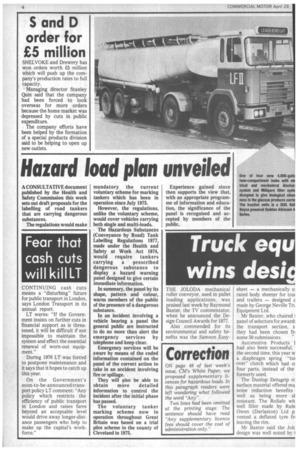Hazard load plan unveiled
Page 6

If you've noticed an error in this article please click here to report it so we can fix it.
A CONSULTATIVE document published by the Health and Safety Commission this week sets out draft proposals for the labelling of road tankers that are carrying dangerous substances.
The regulations would make mandatory the current voluntary scheme for marking tankers which has been in operation since July 1975.
However, the regulations, unlike the voluntary scheme, would cover vehicles carrying both single and multi-loads.
The Hazardous Substances (Conveyance by Road) Tank Labelling Regulations 1977, made under the Health and Safety at Work Act 1974, would require tankers carrying a prescribed dangerous substance to display a hazard warning panel designed to give certain immediate information.
In summary, the panel by its shape, pattern and colour, warns members of the public of the presence of a dangerous substance.
In an incident involving a vehicle bearing a panel the general public are instructed to do no more than alert the emergency services by telephone and keep clear.
Emergency services will be aware by means of the coded information contained on the panel of the correct action to take in an accident involving fire or spillage.
They will .1so be able to obtain more detailed information to control the incident after the initial phase has passed.
The voluntary tanker marking scheme now in operation throughout Great Britain was based on a trial pilot scheme in the county of Cleveland in 1975. Experience gained since then supports the view that, with an appropriate programme of information and education, the significance of the panel is recognised and accepted by members of the public.




















































































































































































